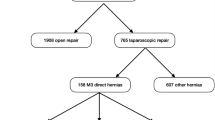Abstract
Traditional inguinal herniorrhaphy continues to be one of the most common surgeries performed in the USA today. The procedure has developed into a straightforward, ambulatory procedure with postoperative complications being very rare. We describe the first report in the literature of the serious complication of hemoperitoneum after open inguinal hernia repair attributed to injury of the artery of Sampson.

Similar content being viewed by others
References
Neumayer L, Giobbie-Hurder A, Jonasson O, Fitzgibbons R Jr, Dunlop D, Gibbs J, Reda D, Henderson W (2004) Open mesh versus laparoscopic mesh repair of inguinal hernia. N Engl J Med. 350(18):1819–1827
Kark AE, Kurzer M, Belsham PA (1998) Three thousand one hundred seventy-five primary inguinal hernia repairs: advantages of ambulatory open mesh repair using local anesthesia. J Am Coll Surg 86:447–456
Frey DM, Wildisen A, Hamel CT, Zuber M, Oertli D, Metzger J (2006) Randomized clinical trial of Lichtenstein’s operation verses mesh plug for hernia repair. Br J Surg 94(1):36–41
Fitzgibbons RJ Jr, Gobbie-Hurder A, Gibbs JO, Dunlop DD, Reda DJ, McCarthy M Jr, Neumayer LA, Barkun JS, Hoehn JL, Murphy JT, Sarosi GA Jr, Syme WC, Thompson JS, Wang J, Jonasson O (2006) Watchful waiting vs repair of inguinal hernia in minimally symptomatic men: a randomized clinical trial. JAMA 295(3):285–292
McCormack K, Scott NW, Go PM, Ross S, Grant AM, EU Hernia Trialists Corporation (2003) Laparoscopic techniques versus open techniques for inguinal hernia repair. Cochrane Database Syst Rev 1:CD001785
Fitzgibbons RJ, Richards AT, Quinn TH (2006) Open hernia repair. In: Souba WW, Fink MP, Jurkovich GJ, Kaiser LR, Pearce WH, Pemberton JH, Soper NJ (eds) ACS surgery: principals and practice. WebMD, New York, pp 764
Hollinshead WH, Rosse C (1985) The inguinal and femoral canals; the scrotum; the applied anatomy of the hernia. In: Hollinshead WH, Rosse C (eds) Textbook of anatomy, 4th edn. Harper & Row, Philadelphia, pp 713–734
Delancey J (1992) Anatomy of the female pelvis. In: Thompson JD, Rock JA (eds) Te linde’s operative gynecology, 7th edn. JB Lippincott, Philadelphia, pp 33–65
Author information
Authors and Affiliations
Corresponding author
Rights and permissions
About this article
Cite this article
Buch, K.E., Reiner, M. & Divino, C.M. Hemoperitoneum following inguinal hernia repair: a case report. Hernia 11, 459–461 (2007). https://doi.org/10.1007/s10029-007-0212-9
Received:
Accepted:
Published:
Issue Date:
DOI: https://doi.org/10.1007/s10029-007-0212-9




